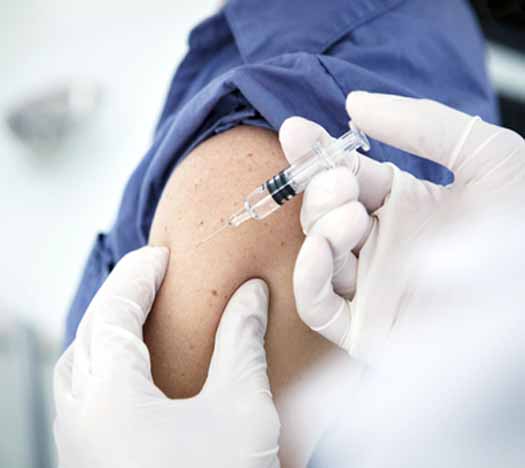Insurers are susceptible to fluctuations in mortality experience due to varying severity of seasonal influenza from year to year. They are especially concerned with the rarer but dreaded threat of pandemic influenza posing significant risk to insured lives portfolios.
Research to develop a universal influenza vaccine, often referred to as the Holy Grail of vaccine development, has been going on for quite some time with no success to date, but there have been recent developments in the quest to develop the world’s first universal flu vaccine. This quest, if successful, could impact an insurer’s bottom line.
Influenza Basics
There are two main epidemiological forms of influenza: seasonal and pandemic. Influenza A and B cause seasonal (annual) epidemics and lead to 300,000-500,000 deaths per year globally. Influenza A, which affects both animals and humans, is the only one documented that emerges periodically (and unpredictably) to cause pandemics.1 (B only affects humans.)
There have been four influenza pandemics in the last 100 years: 1918 (50,000,000+ deaths), 1957 (1,100,000 deaths), 1968 (1,000,000 deaths), and 2009 (151,700-575,400 deaths).2 Concern is growing that animal influenza viruses, which do not currently have sustained human-to-human transmission, could undergo a mutation that would confer efficient transmission among humans and cause the next pandemic.
Current strategies for seasonal vaccine production are essentially one year behind in terms of keeping up with flu virus variation. With regard to pandemic influenza risk, the current approach leads to making, testing, and stockpiling vaccines that may never be used.1 Furthermore, seasonal flu vaccines provide essentially no protection against an emerging pandemic strain.
New Focus on Universal Influenza Vaccine Research
The outer surface of all flu viruses displays two well-studied proteins: hemagglutinin (H) and neuraminidase (N). The H and N proteins are what classify and differentiate influenza viruses (and how strains of flu viruses get their names; e.g., H1N1, H3N2). The H protein has two components, a head and a stem. Typical seasonal flu vaccines target the head, but this region also experiences frequent antigenic changes, or “drifts,” necessitating new flu vaccines every year. The stem portion remains more constant over time and therefore represents an ideal focus for longer-lasting and broader-coverage universal flu vaccines.3 There is some new vaccine research also being directed at the N protein, but most remains focused on the H protein.4
In February 2018, the National Institute of Allergy and Infectious Diseases (NIAID) published a Universal Influenza Vaccine Strategic Plan to chart the course for research priorities. It recommended the following: that a universal flu vaccine should be at least 75% effective; protect against two groups of influenza A viruses; have durable protection that lasts at least one year; and be suitable for all age groups.1
Then, in April 2018, the Bill & Melinda Gates Foundation issued “Ending the Pandemic Threat: A Grand Challenge for Universal Influenza Vaccine Development.” The goal of this challenge was to “identify novel, transformative concepts that will lead to development of universal influenza vaccines offering protection from morbidity and mortality caused by all subtypes of circulating and emerging influenza A subtype viruses and influenza B lineage viruses for at least three to five years.”5 In addition, “it is envisaged that such a universal influenza vaccine would address the threat from both seasonal and pandemic influenza, thus alleviating the need for annual seasonal influenza vaccination campaigns.”5 The Gates challenge seeks transformative approaches rather than incremental research.
The timing for such initiatives has never been better. The probability of successful development of a universal flu vaccine is more feasible now than even a decade ago due to advances in virology, immunology, vaccinology, deep gene sequencing, and structural biology.1 In fact, several universal flu vaccine clinical trials have recently been announced, indicating the research is now moving from theoretical to operational.
In vaccine development there are four phase types,6,7 all of which are time-consuming, complex, and costly. A brief description of each follows:
Phase I: Small-scale trials to determine safety in humans and the immune response evoked; conducted in individuals at low risk for the infection the vaccine is designed to prevent
Phase II: Large-scale studies to look at the efficacy of the vaccine against artificial (i.e., intentional) infection and clinical disease; may include an at-risk population
Phase III: Large-scale studies across several geographic sites to determine vaccine efficacy under natural disease conditions; includes an at-risk population
Phase IV: The vaccine is licensed and introduced to the public, also called post-marketing surveillance
Current Trials
The National Institutes of Health (NIH) announced in April 2019 the opening of a Phase I clinical trial of an innovative universal influenza vaccine candidate, H1ssF_3928. The trial is being conducted at the NIH Clinical Center in Bethesda, Maryland (U.S.) and aims to enroll 53 healthy adults between the ages of 18 and 70. The researchers will study how participants respond to the vaccine, which is directed toward the stem of the H protein, based on age and previous exposure to different influenza strains. Early reports on the study should be available in 2020.8
Two additional studies are being conducted by a private company. It has administered a pandemic universal influenza A vaccine to the first participants in a Phase II study being conducted in Antwerp, Belgium, according to a communication issued on June 5, 2019. Additionally, the company announced that it had administered the vaccine to 2,200 people in a Phase II field trial in Australia. In this case, the new vaccine was co-administered with the current quadrivalent seasonal flu vaccine to determine whether the combination might offer improved efficacy over the standalone seasonal vaccine. Results of these studies are also expected in 2020.9
An Israeli company has announced completion of enrollment for a Phase III universal flu vaccine trial in late 2018. It will enroll a second cohort during the 2019-2020 flu season. Results from this study will also be available in the second half of 2020.12
While not a clinical vaccine trial per se, the Cincinnati Children’s Hospital Medical Center announced on May 2, 2019, that it received a US$30 million federal grant to accelerate research on a universal flu vaccine. Specifically, these researchers will study how the immune systems of infants and growing children are imprinted by their first exposures to flu viruses. The research cohort will consist of individuals from Cincinnati and Mexico City.10
While news has generally been favorable and positive regarding the prospects and advancements of universal flu vaccine development, there have been some setbacks. A large pharmaceutical firm, for example, recently terminated a universal flu vaccine candidate after reviewing interim Phase I data. The reason: the vaccine had induced an immune response, but the boosting effect of a second dose was not as strong as expected. Additionally, the results were insufficient to conclude the benefit would be supra-seasonal.11
Insurance Implications and Conclusions
Actuaries and insurance medical directors have long studied and modeled the impact of mortality variation due to seasonal influenza and the greater risk of pandemic influenza. The latter is especially important, as modeling is required as part of regulatory reserving calculations. There is no doubt that the development and deployment of a successful universal influenza vaccine would have an immensely favorable impact on society as well as on insurers’ mortality risk liabilities. While not a focus of this article, it would also significantly reduce morbidity through lower health costs and hospitalization reimbursement.
Although a universal influenza vaccine has not yet been produced, recent developments in technology have advanced this search to a new stage. Overall prospects for success are greater now than at any time in history. While it may be too early for insurers to definitively expect morbidity and mortality improvements, it certainly may be time to at least begin planning for that day.



